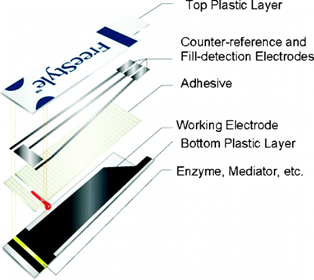We are experimenting with a glucose test strip (below) in our chemistry lab using an electrochemical method where a potential is applied (150 mV) across the working and reference electrodes and the resulting current is measured across the working and counter electrodes.
We have found that sampling time is critical, so we set up a sample detection relay system using the test strip’s fill-detection electrode. When the sample reaches the electrodes, we detect very low mV across the fill-detection and reference electrodes that the relay itself cannot directly detect.
This setup amplifies the output (the two red leads) from the fill detection/reference electrodes (from mV to V) and that signal hits the relay, which triggers the instrument to start collecting data. The electronics triggering setup is working great. The problem we are running into is a tremendous amount of background noise.
This is the signal without the relay system connected (manual start is used):
When the relay system attached:
We can use the instrument’s software to get this smoothed response, but even so it does not compare to the very smooth and more precise signals we get when the relay system is not connected.
Is there anything we can try, electronics circuit-wise, to reduce this noise?






that signal hits the relaymean? ... please add a circuit diagram to your post ... use the schematic editor that is available when you edit your question ... clicksave and insertwhen you complete drawing the circuit diagram \$\endgroup\$